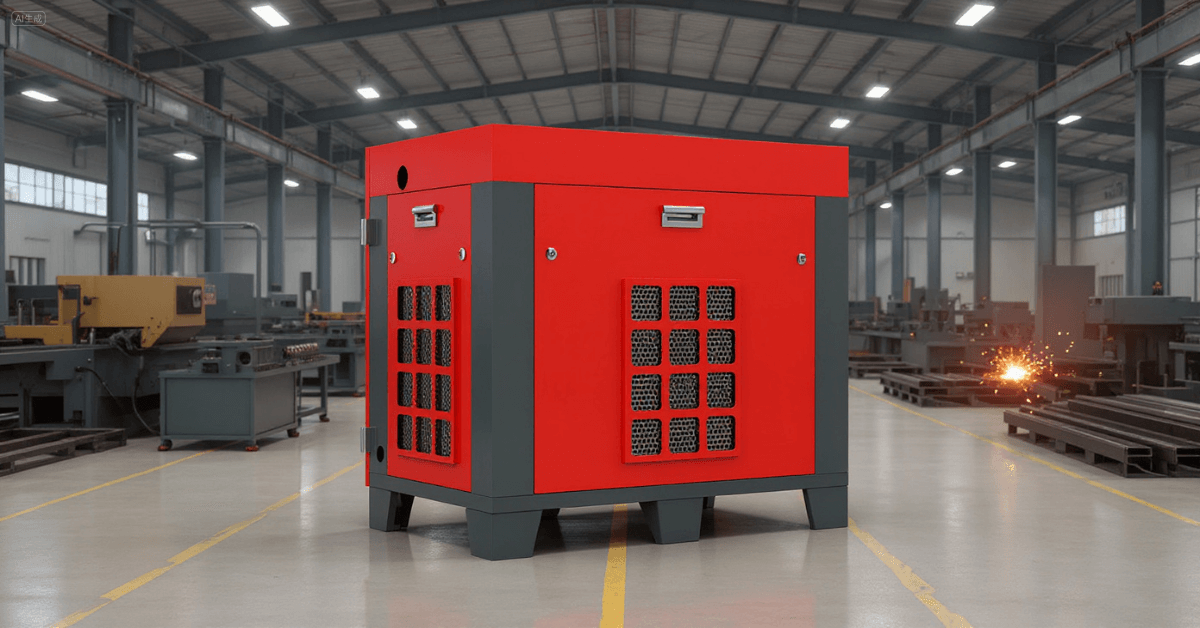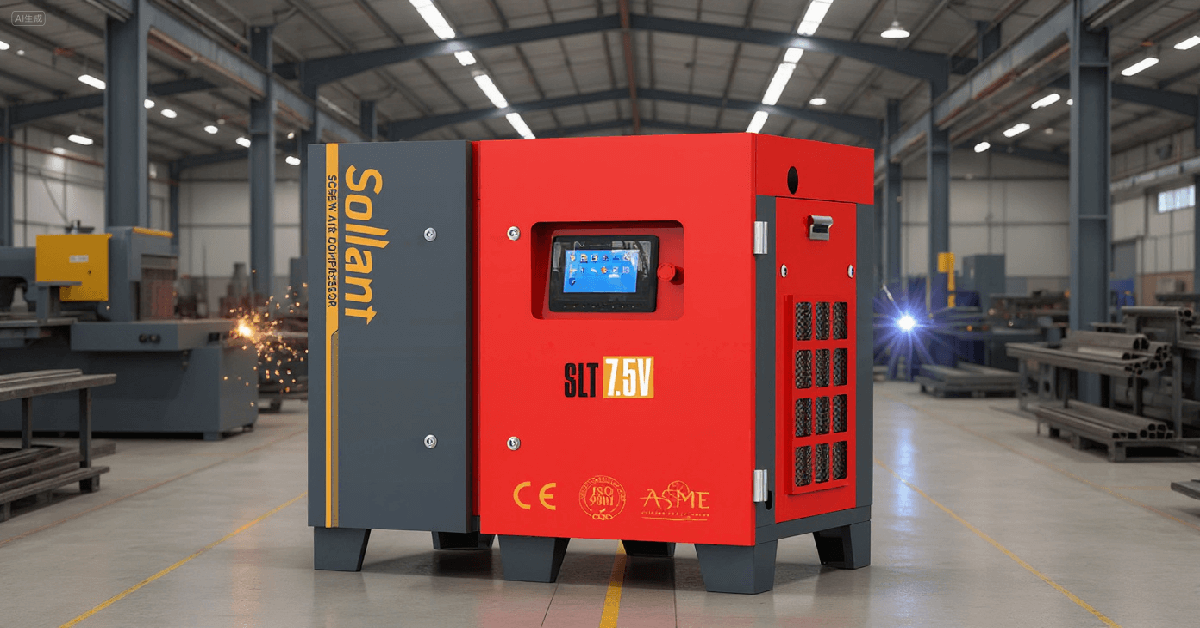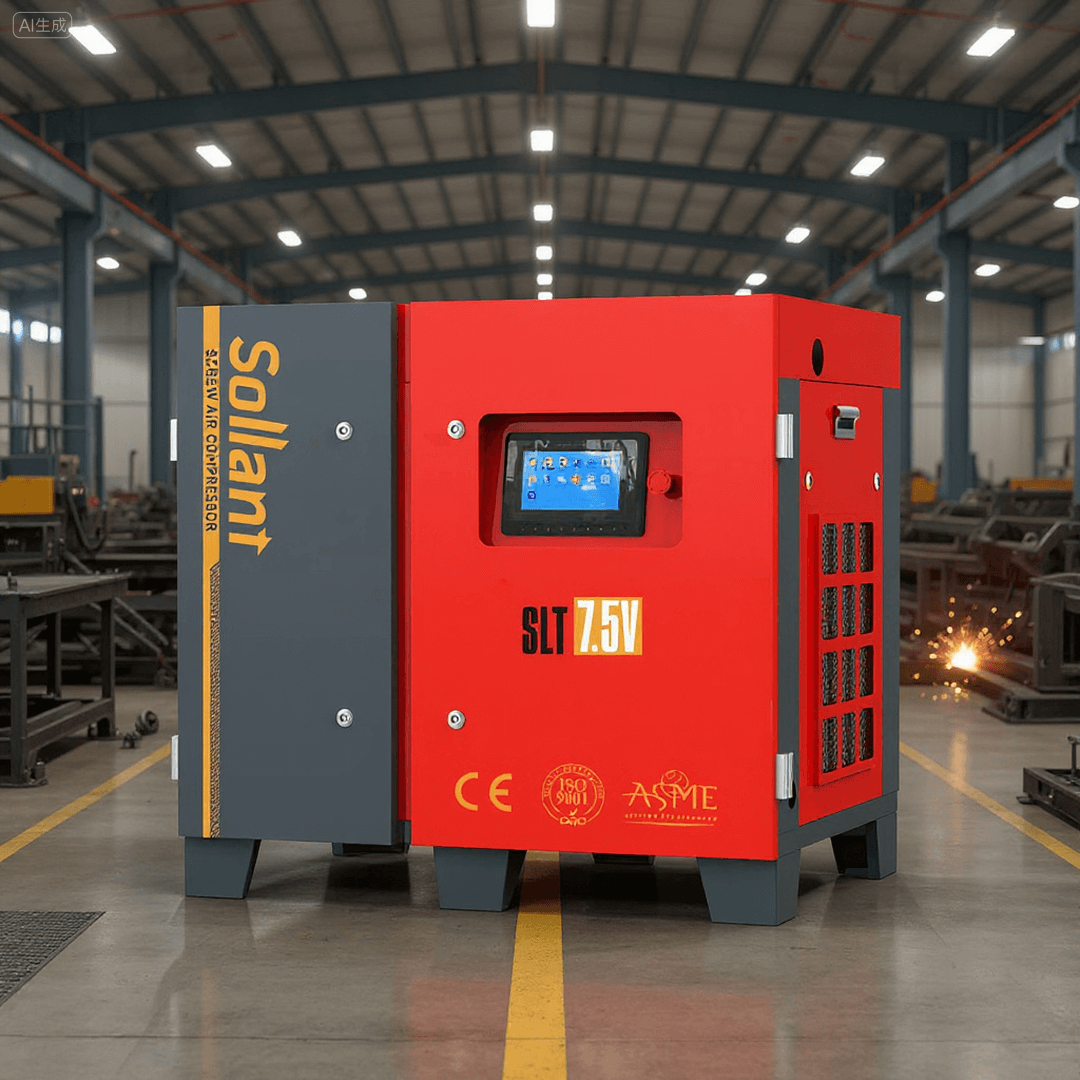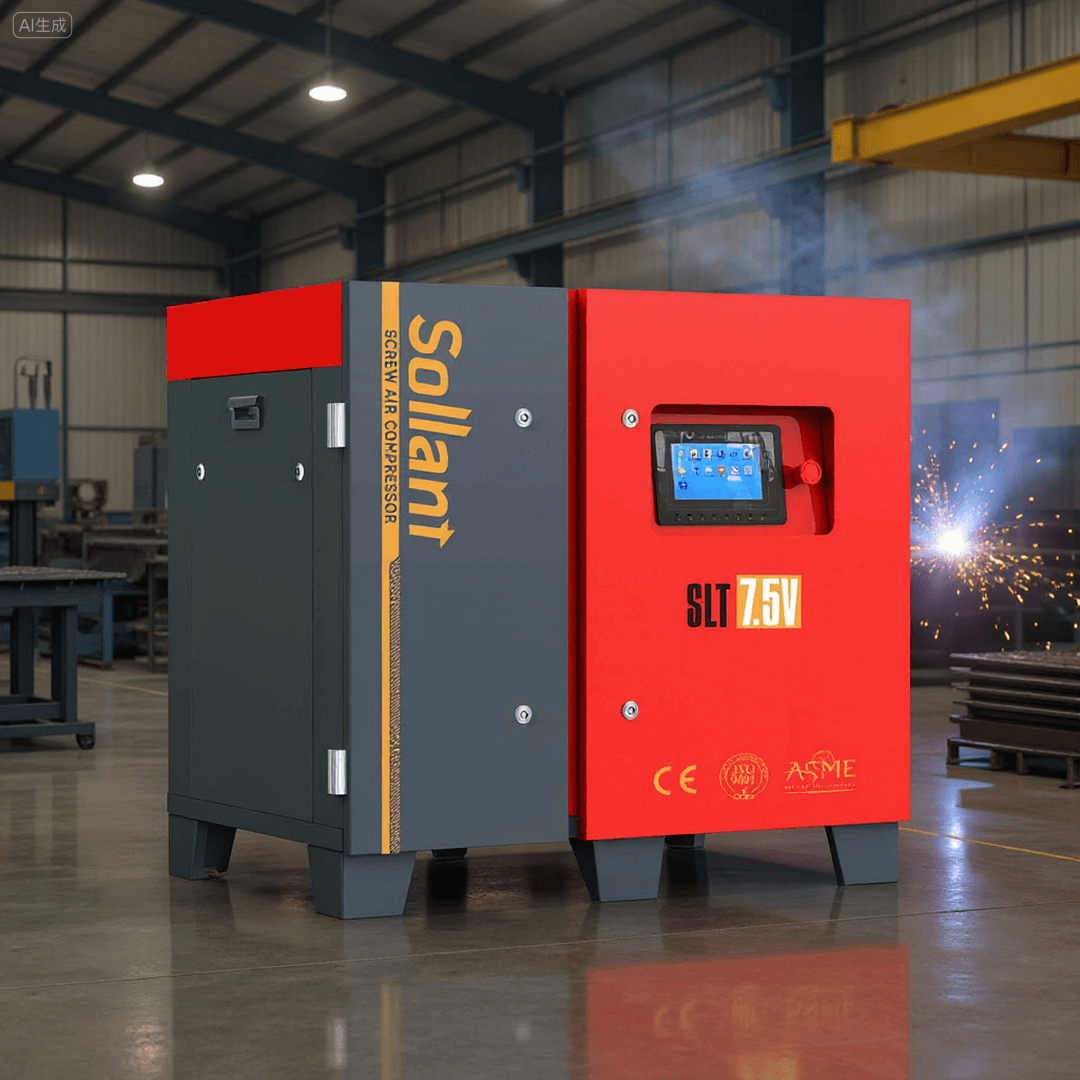Practical Solutions for High Oil Consumption in Screw Compressors

What are the most effective ways to fix excessive oil consumption in screw compressors? You can take control using clear, step-by-step solutions. Keeping oil use within safe limits saves you money and protects the quality of your compressed air. Industry standards say the residual oil content at the compressor outlet should stay below 3ppm. Sollant offers advanced technology to help you meet these targets and keep your system running efficiently.
Table of Contents
Key Takeaways
Check the oil level regularly. Keep it between the ‘MAX’ and ‘MIN’ marks to prevent excessive oil consumption.
Inspect for leaks around seals and connectors. Tighten or replace damaged parts to stop oil loss.
Clean or replace filters to ensure proper airflow. Dirty filters can lead to increased oil use.
Adjust operating settings to match manufacturer recommendations. Proper pressure and temperature help reduce oil consumption.
Perform regular maintenance checks. Consistent care keeps your compressor running efficiently and prevents costly repairs.
Quick Actions
When you notice excessive oil consumption in your screw compressor, you can take immediate steps to control the problem. These quick actions help you avoid costly downtime and protect your equipment.
Check Oil Level
Start by checking the oil level in your compressor. Look at the sight glass or dipstick and compare the reading to the “MAX” and “MIN” marks. If the oil level is above “MAX,” drain the excess oil until it reaches the correct range. Too much oil can cause rapid oil mist formation and increase excessive oil consumption. If the oil level drops quickly, record the amount and frequency. This information helps you track patterns and spot issues early.
Inspect for Leaks
Walk around your compressor and look for oil stains or puddles under the machine. Pay close attention to seals, connectors, and joints. Use a flashlight to check for drips or spray near the shaft ends and oil pipes. If you find leaks, tighten loose connections or replace damaged seals. Quick leak repairs prevent further loss and keep your system clean.
Tip: Sollant offers durable seals and connectors designed for high-pressure environments. Upgrading to these parts can reduce leaks and improve reliability.
Clean or Replace Filters
Dirty filters can restrict airflow and cause excessive oil consumption. Remove the intake filter and inspect it for dust or oil buildup. Clean the filter with compressed air if possible. If the filter looks blackened or damaged, replace it with a new one. Sollant’s high-efficiency filters trap more particles and last longer, helping you maintain optimal performance.
Review Operating Settings
Check your compressor’s operating pressure and temperature. Make sure the exhaust pressure matches the recommended range on the equipment nameplate. High pressure or temperature can force more oil into the air stream. Adjust the settings as needed to stay within safe limits. If you run your compressor at low load for long periods, consider changing your operating schedule to avoid uneven oil separation.
Note: Using Sollant’s advanced control systems makes it easier to monitor and adjust settings, reducing excessive oil consumption and improving efficiency.

Signs of Excessive Oil Consumption
Fast Oil Level Drop
You should watch your compressor’s oil level closely. If you notice the oil level dropping from “MAX” to below “MIN” in just a few days, this is a clear warning sign. Frequent refueling or the need to add oil more than once a month often points to a problem. Maintenance professionals report that a fast oil level drop can result from issues like a damaged oil separator, a blocked oil return line, or a faulty check valve. The table below shows common signs, causes, and solutions:
Sign of Excessive Oil Consumption | Cause | Solution |
|---|---|---|
High motor current | Clogged oil separator element | Monitor pressure differential; replace the element at 0.08 MPa |
Severe oil consumption | Damaged oil separator element | Replace with high-quality components |
Excessive refueling | Overfilling or leaks | Drain oil to normal level; repair leaks |
Oil not returning to compressor | Improper oil return pipe installation | Adjust pipe depth and angle |

Oil in Compressed Air
You may spot oil stains on tools, pipes, or even on a white paper held at the exhaust port. Oil in compressed air means the separator is not working well or the oil level is too high. This can cause several problems for your equipment and products:
Oil contamination in compressed air can lead to costly and dangerous outcomes in food manufacturing.
Contaminated compressed air can decrease productivity and lead to product recalls.
Excess oil can harm machinery and the end product, creating a risk for microbiological growth in the distribution system.
If you see these signs, act quickly to protect your system and maintain air quality.
Abnormal Operation
Abnormal operation often goes hand in hand with excessive oil consumption. You might notice high exhaust temperatures, fluctuating oil pressure, or strange noises. Sometimes, the compressor may trip or show high motor current. These symptoms can result from a clogged oil separator, a faulty minimum pressure valve, or poor-quality lubricants. Here are some frequent user-reported issues and their solutions:
Issue Description | Solution |
|---|---|
Damaged oil return check valve | Clean or replace the non-return valve |
Blocked oil return line | Clear blockages in the oil return pipe |
Minimum pressure valve failure | Repair or replace the minimum pressure valve |
Non-standard separator tank design | Consult manufacturer for design improvements |
By recognizing these signs early, you can prevent bigger problems and keep your compressor running smoothly.
Causes of Excessive Oil Consumption
Understanding why your screw compressor uses too much oil helps you fix problems quickly. Several technical reasons can lead to excessive oil consumption. You can spot these issues by looking at the main parts and how you operate your compressor.
Oil Separator Issues
The oil separator keeps oil inside the compressor and out of the compressed air. When this part fails, oil escapes and increases your costs. You might see oil in the air lines or notice you need to refill oil more often. Common faults include:
Faulty oil separators or worn seals let oil leak into the air or out of the machine.
Overfilled oil reservoirs push oil into the air system.
Improperly working air/oil separators allow too much oil to escape with the compressed air.
You can see how oil injection and distribution affect performance in the table below:
Findings | Implications |
|---|---|
Oil injection through two separate ports reduces maximum gas temperature by 30°–35°C | Leads to reduced specific power by 1.8% |
Even oil distribution improves performance and efficiency | Enhances overall compressor operation |
Seal and Connector Problems
Seals and connectors keep oil where it belongs. If these parts wear out or become loose, oil leaks can happen. You may find oil stains near shaft ends, joints, or under the compressor. Replacing worn seals and tightening connectors helps prevent these leaks.
Operating Conditions
How you run your compressor matters. Air quality and temperature in your workspace can change how much oil your machine uses. For example:
Dirty air can break down the oil faster.
High temperatures shorten oil life and increase oil use.
Poor maintenance routines can make these problems worse.
Regular checks and clean air help you control oil use.
Maintenance Errors
Mistakes during maintenance often cause excessive oil consumption. If you forget to clean filters or replace worn parts, oil can escape or break down faster. The table below shows common errors and solutions:
Causes | Solutions |
|---|---|
Clean filters and oil return pipe | |
Reduced oil separator efficiency | Replace oil separator core |
Excessive oil in the secondary oil separator | Control oil level and reduce oil temperature |
High exhaust temperature |
Paying attention to these areas helps you keep oil use under control and your compressor running smoothly.
Solutions and Repairs
Replace Oil Separator
You should start by replacing the oil separator if you notice high oil carryover or a rapid drop in oil level. A worn or clogged separator cannot filter oil mist effectively, which leads to excessive oil consumption. Follow these steps to ensure proper replacement and long-term reliability:
Change the air-oil separator and lubricant according to the manufacturer’s schedule. For spin-on types, replace every 4,000 hours. For drop-in types, replace every 8,000 hours or once a year.
Monitor the pressure differential across the separator. If the pressure drop exceeds 10 PSIG, replace the element immediately.
Inspect the scavenge line and orifices for clogs. Clean them to ensure oil drains properly back to the tank.
Check and service the pressure retention valve. This prevents backflow and gas collisions that can damage the separator.
Always use high-quality replacement parts. Sollant’s oil separators use advanced filter materials and precise manufacturing, which help maintain low oil carryover and extend service life.
Tip: Regularly monitoring the operating temperature helps prevent oil vaporization and overheating, both of which can increase oil loss.
Fix Seals and Connectors
Leaking seals and connectors are common sources of oil loss. You can prevent further damage by addressing these issues quickly:
High-pressure environments can deform seal edges, causing leaks. Replace seals that show signs of wear or deformation.
Temperature changes can reduce the effectiveness of rubber seals. Inspect seals regularly and replace them if they become brittle or cracked.
Vibration and shock can loosen connectors or damage seals. Tighten all connections and replace any that appear worn.
Use seals made from materials suited to your compressor’s environment. Incorrect material selection or improper installation can lead to premature failure.
Track leakage volume after repairs. This helps you measure the success of your maintenance efforts.
Sollant offers durable seals and connectors designed for high-pressure and high-temperature environments. Upgrading to these components can reduce leaks and improve system reliability.
Adjust Operating Parameters
You can control oil consumption by optimizing your compressor’s operating parameters. Small adjustments make a big difference in efficiency and oil use. The table below shows how different parameters affect oil consumption rates:
Operating Parameter | Impact on Oil Consumption Rates |
|---|---|
Oil Flow Rate | High flow rates increase frictional losses and fuel use. Optimal rates reduce consumption. |
Injection Pressure | Changes affect oil flow rate and overall fuel consumption. |
Orifice Size | Fixed based on oil flow rate; affects flow velocity and oil use. |
Operating Speed | Oil flow rate has a larger effect on power consumption at lower speeds. |
Discharge Pressure | Variations influence oil injection pressure and flow rate, impacting total oil consumption. |
You should keep your compressor’s discharge pressure and oil flow within the recommended range. Avoid running the machine at low load for long periods. This helps maintain efficient oil separation and reduces the risk of excessive oil consumption.
Improve Maintenance Practices
Consistent maintenance keeps your compressor running efficiently and prevents oil-related problems. You can follow a structured schedule to reduce oil loss and extend equipment life. The table below outlines best practices:
Maintenance Type | Practice Description |
|---|---|
Daily | Check oil level and refill with the recommended grade of oil. |
Weekly | Inspect air filter for cleanliness and check belt tension and condition. |
Monthly | Clean cooler fins and check for excessive vibration. |
Quarterly | Change oil and oil filter; inspect pressure relief valves. |
Annual | Conduct a full system inspection, including electrical connections and motor bearings. |
You should always use the correct grade of oil and genuine replacement parts. Clean filters and coolers regularly. Record maintenance activities and monitor oil usage trends. This approach helps you catch issues early and avoid costly repairs.
Use Sollant Parts and Service
Sollant provides advanced parts and expert service to help you control oil consumption and improve compressor reliability. The table below highlights key advantages of Sollant’s solutions:
Advantage | Description |
|---|---|
No oil pollution | Sollant oil-free scroll compressors do not require lubricating oil, saving 20-30% of energy. |
Cleaner compressed air | The compressors deliver oil-free air, ideal for industries with strict purity requirements. |
Reduced maintenance cost | No regular oil changes needed, which simplifies maintenance and lowers costs. |
Increased productivity | Eliminates downtime for oil changes, keeping your production running smoothly. |
Environmental benefits | No waste oil or oil mist, supporting environmental protection efforts. |
Sollant’s high-density filter materials and nano-plating technology ensure efficient filtration and long service life. You can customize parts to fit your specific needs. Sollant’s technical support team provides training and on-site assistance, helping you implement solutions that reduce excessive oil consumption and keep your system operating at peak performance.
Note: Choosing Sollant’s genuine parts and professional service gives you peace of mind and long-term savings.
Preventive Measures
Regular Inspections
You can prevent excessive oil consumption by performing regular inspections. Routine checks help you catch problems early and keep your compressor running smoothly. Follow this inspection checklist to maintain optimal oil control:
Inspect the oil pan, valve covers, and engine covers for leaks.
Check the PCV system for any malfunctions that might increase oil use.
Make sure the compressor operates within a normal temperature range to avoid excessive wear.
Verify the correct amount and viscosity of oil during each lube service.
Wait at least 15 minutes after shutdown before checking the dipstick, so oil drains fully into the crankcase.
You should record inspection results and address any issues right away. Consistent inspections help you avoid costly repairs and downtime.
Standardized Consumables
Using standardized consumables is essential for long-term oil control. You should always choose compressor oils that are designed for high compression temperatures. These oils resist oxidation and prevent carbon deposits. Standardized oils help your compressor run efficiently and last longer. When you use the right oil and genuine replacement parts, you reduce the risk of breakdowns and keep your system clean. Sollant offers high-quality consumables that meet international standards, giving you peace of mind and reliable performance.
Optimized Operation
Optimizing your compressor’s operation helps you maintain stable oil levels and extend equipment life. You can follow these best practices to achieve long-term oil control:
Schedule regular maintenance checks to keep all components in good condition.
Manage lubrication carefully to maintain the right oil level and quality.
Ensure proper ventilation in your compressor room to prevent overheating and oil degradation.
You should avoid running your compressor at low load for long periods. Adjust your operating schedule to match production needs. These steps help you reduce oil loss and improve efficiency.
Sollant Maintenance Support
Sollant provides expert maintenance support and advanced oil control solutions for your screw compressor. You benefit from technical guidance, on-site service, and genuine parts. Sollant’s team helps you set up a preventive maintenance plan tailored to your needs. You can rely on their high-density filter materials and nano-plating technology for clean, contaminant-free air. The table below shows the long-term benefits of using Sollant’s advanced solutions:
Benefit | Description |
|---|---|
Clean, Contaminant-Free Air | You get pure air with no oil contamination, which is vital for sensitive industries. |
Reduced Operational Costs | Energy-efficient design lowers electricity use, saving you money over time. |
Low Maintenance and Longer Lifespan | Fewer moving parts mean less maintenance and a longer compressor life. |
Environmental Benefits | No oil leaks or contamination, supporting sustainability and a lower carbon footprint. |
Compliance with Regulatory Standards | You meet strict air quality and environmental rules, delivering pure, dry air. |
Quiet Operation | Your compressor runs quietly, which is ideal for noise-sensitive environments. |
Sollant’s maintenance support helps you prevent excessive oil consumption and keep your compressor working at its best.
Troubleshooting Guide
Diagnostic Checklist
You can solve many oil consumption problems by following a systematic diagnostic checklist. Industry experts recommend that you start with basic service readings. Record air, oil, water, temperature, and pressure levels. These numbers help you spot abnormal patterns.
Next, check for leaks. Look for air, water, and oil escaping from the system. Inspect the air intake chamber for blockages or contamination. Examine all filters and filter elements. Dirty or damaged filters can cause oil to pass into the compressed air.
Adjust valves and switches as needed. Loose or faulty valves may let oil escape. Tighten bolt and coupling connections. Replace worn rubber inserts. Check the fans, air paths, motors, and drive gears for wear or damage.
Clean the cooling system and confirm it works properly. Inspect all oil elements and change the oil if needed. Look for water in the oil, which can signal a bigger issue. Examine wiring and connections for looseness. Clean the gearcase and check hose conditions.
You should also pay attention to warning signs:
Error messages on the compressor’s monitoring system
Excess moisture or condensation
Unusual noise or rattling
Frequent breaker trips
Loss of air pressure
Overheating or hot discharged air
Oil in discharged air or oil with a milky appearance
Tip: Keeping a log of these checks helps you track changes over time and catch problems early.

When to Call Experts
Some oil consumption issues require professional help. You should consult an expert if you notice any of the following signs:
Implication | Action Required | |
|---|---|---|
Regular oil top-offs | Indicates an underlying problem | Consult an expert for diagnosis |
Sudden oil loss through suction port | May indicate a failed suction check valve | Immediate expert attention |
Continuous oil loss through economizer | Failing economizer check valve | Repair or upgrade needed |
Coalescing element failures | Discharge port oil loss | Immediate replacement needed |
If you see sudden oil loss or frequent top-offs, you should not wait. These problems often point to deeper mechanical faults. Expert technicians use advanced tools and experience to diagnose and fix issues quickly. Sollant’s service team can help you restore your compressor’s performance and prevent future oil loss.
Note: Early expert intervention saves you time, money, and protects your equipment from further damage.
You can solve excessive oil consumption by following proven steps. Start with regular oil changes, monitor oil levels, and maintain clean air filters. Check for leaks and adjust oil flow rates to balance performance and prevent condensation. Many industries now use oil-free or water-lubricated compressors for pure compressed air. These actions help you save money, reduce downtime, and improve reliability. Sollant offers advanced solutions and expert support. Visit Sollant’s website for more ways to keep your compressor running efficiently.
FAQ
What causes high oil consumption in screw compressors?
You often see high oil use from worn oil separators, damaged seals, or incorrect operating settings. Poor maintenance and using the wrong oil can also increase consumption. Regular checks help you spot these problems early.
How often should you replace the oil separator?
You should replace the oil separator every 2,000 to 4,000 hours of operation. Always follow your compressor’s manual for exact intervals. Using Sollant’s high-quality separators helps you extend service life and maintain low oil carryover.
Can you use any type of oil in your screw compressor?
No, you should always use the oil recommended by your compressor manufacturer. Using the wrong oil can cause poor lubrication, higher oil consumption, and even damage. Sollant offers oils designed for high performance and long life.
What are the signs of oil leaks in a compressor?
You may notice oil stains under the machine, drops near seals, or oil in the compressed air. Unusual noises or frequent oil top-offs also signal leaks. Quick repairs prevent bigger problems.
How does Sollant help reduce oil consumption?
Sollant provides advanced oil separators, durable seals, and high-efficiency filters. These parts keep oil inside the system and deliver clean air. Sollant’s expert support helps you set up preventive maintenance for long-term savings.


